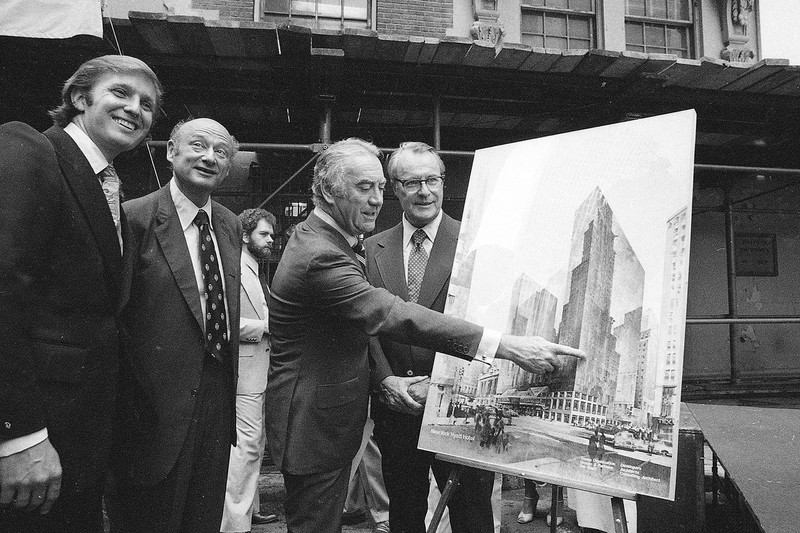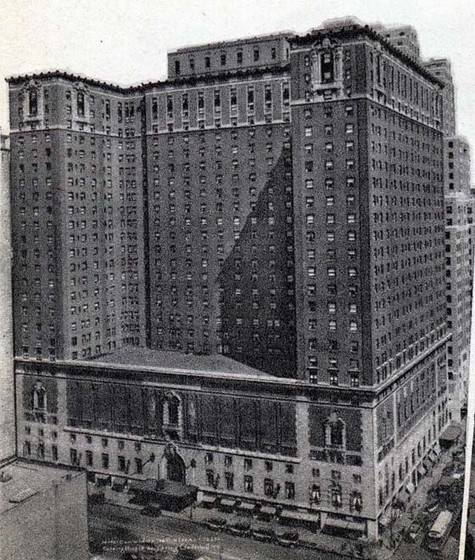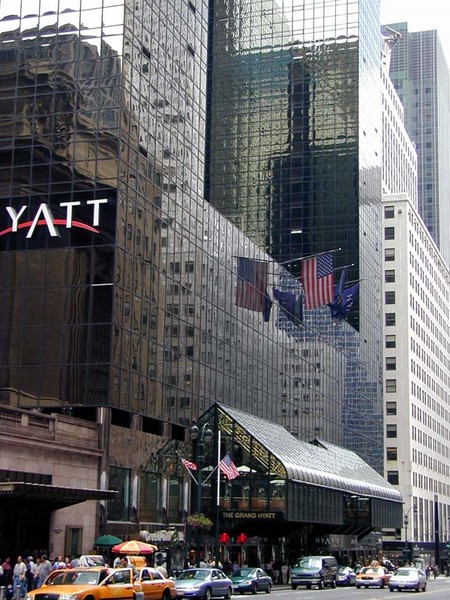The Grand Hyatt Hotel
Introduction
Text-to-speech Audio
Originally designed by The Bowman-Biltmore Hotels, the 2,000-room building was named the Commodore in honor of "Commodore" Cornelius Vanderbilt, originator of the New York Railroad system. Opening its doors in 1919, it had a successful six-decade run before financial issues nearly forced its closure. In 1976, businessman Donald Trump, bought the hotel in an attempt to save it and moved to refurbish the building. The ensuing public battles regarding tax breaks placed the building and its owner into the national limelight.
Images
Donald Trump showing the plans for the new redo.

The original Commodore Hotel.


Backstory and Context
Text-to-speech Audio
Originally named the Commodore Hotel, the Grand Hyatt New York was originally designed by Herbert R. Stone. The hotel, located near and connected to Grand Central Terminal, opened its doors on January 28, 1919 with 2,000 rooms. Boasting a lobby called the "Most Beautiful The World" with low ceilings and an indoor waterfall, the hotel featured a ballroom with its own orchestra. Prominent guests included Albert Einstein, who stayed here when in New York City to promote the opening of his Hebrew University in Jerusalem in 1921.
The Commodore Hotel remained successful for decades. However, this changed in 1977 when news broke that the hotel was struggling financially and had lost $1.5 million the previous year. When this occurred, Donald Trump, a local businessman, bought the Commodore. Trump was born in the world of New York real estate, with his father being a wealthy apartment developer. Donald Trump gained his start in business with a degree in finance from the University of Pennsylvania's Wharton School of Finance in 1968. Throughout his years as a developer, Trump bought and renovated several Manhattan hotels. Eventually, by gaining more tax concessions, he would take over his father's business and oversee further growth.
Donald Trump convinced the Hyatt hotel chain to partner with the Trump Organization and purchase the Commodore. Wanting to revitalize the area and the hotel, Trump invested $100 million to renovate the historic hotel into a newer, modernized version. He hired Der Scutt, a renowned architect, to oversee the process. Scutt, a modernist architect, had many projects under Trump. His most famous works included glass windows and exteriors and lavish bronze and gold works. His plans for the Commodore included a new, lavish reflective glass exterior, with the only untouched section of the building being the foyer that led to the ballroom. The renovated hotel opened in 1980 to much fanfare. However, the story was not yet finished. The building cost a large amount of money and the finances were still in the air.
To pay for the extensive project, Donald Trump needed to gain financial support from the local government. What arose was a groundbreaking 40-year tax break, the first ever given to a commercial project. Trump would use his father's and his own political connections to gain his groundbreaking concessions. The finished project opened in 1980. In retrospect, the tax breaks proved widely unpopular. Since the total project cost $120 million, the city would eventually go on to lose over $360 million in uncollected taxes.
The hotel project spanned a controversial sixteen years. Eventually, in 1993, Donald Trump filed a lawsuit against the Pritzkers, leaders of the Hyatt organization. Trump argued that the family was using finances for the hotel and other areas for other means. Eventually, the Pritzkers countersued and stated that Trump was not as involved with the greater business dealings of the hotel. Finally, in 1996 Trump sold his share of the hotel to Hyatt for $142 million, ending the partnership for good. Hyatt completely renovated the hotel in 2011, a project that included removal of the 1980s modern changes, at a cost of $130 million.
The Commodore Hotel remained successful for decades. However, this changed in 1977 when news broke that the hotel was struggling financially and had lost $1.5 million the previous year. When this occurred, Donald Trump, a local businessman, bought the Commodore. Trump was born in the world of New York real estate, with his father being a wealthy apartment developer. Donald Trump gained his start in business with a degree in finance from the University of Pennsylvania's Wharton School of Finance in 1968. Throughout his years as a developer, Trump bought and renovated several Manhattan hotels. Eventually, by gaining more tax concessions, he would take over his father's business and oversee further growth.
Donald Trump convinced the Hyatt hotel chain to partner with the Trump Organization and purchase the Commodore. Wanting to revitalize the area and the hotel, Trump invested $100 million to renovate the historic hotel into a newer, modernized version. He hired Der Scutt, a renowned architect, to oversee the process. Scutt, a modernist architect, had many projects under Trump. His most famous works included glass windows and exteriors and lavish bronze and gold works. His plans for the Commodore included a new, lavish reflective glass exterior, with the only untouched section of the building being the foyer that led to the ballroom. The renovated hotel opened in 1980 to much fanfare. However, the story was not yet finished. The building cost a large amount of money and the finances were still in the air.
To pay for the extensive project, Donald Trump needed to gain financial support from the local government. What arose was a groundbreaking 40-year tax break, the first ever given to a commercial project. Trump would use his father's and his own political connections to gain his groundbreaking concessions. The finished project opened in 1980. In retrospect, the tax breaks proved widely unpopular. Since the total project cost $120 million, the city would eventually go on to lose over $360 million in uncollected taxes.
The hotel project spanned a controversial sixteen years. Eventually, in 1993, Donald Trump filed a lawsuit against the Pritzkers, leaders of the Hyatt organization. Trump argued that the family was using finances for the hotel and other areas for other means. Eventually, the Pritzkers countersued and stated that Trump was not as involved with the greater business dealings of the hotel. Finally, in 1996 Trump sold his share of the hotel to Hyatt for $142 million, ending the partnership for good. Hyatt completely renovated the hotel in 2011, a project that included removal of the 1980s modern changes, at a cost of $130 million.
Sources
Bagli, Charles V. "A Trump Empire Built on Inside Connections and $885 Million in Tax Breaks." The New York Times September 17, 2016.
Bernstein, Fred A. "Makeover at Grand Hyatt Sheds the Trump Glitter." The New York Times January 11, 2011.
Clark, Kenneth R. "Out To Trump The Pritzkers." Chicago TribuneJanuary 29, 1993.
Trump, Donald J. Schwartz, Tony. Trump: The Art of the Deal. New York City, New York. Ballantine Books, 2009.
Bernstein, Fred A.. "Der Scutt, Modernist Architect, Dies at 75." The New York Times(New York)March 16, 2010. .
Bernstein, Fred A. "Makeover at Grand Hyatt Sheds the Trump Glitter." The New York Times January 11, 2011.
Clark, Kenneth R. "Out To Trump The Pritzkers." Chicago TribuneJanuary 29, 1993.
Trump, Donald J. Schwartz, Tony. Trump: The Art of the Deal. New York City, New York. Ballantine Books, 2009.
Bernstein, Fred A.. "Der Scutt, Modernist Architect, Dies at 75." The New York Times(New York)March 16, 2010. .
